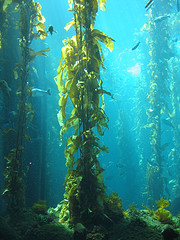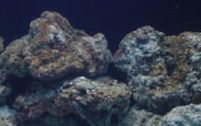
Brown Algae belong to the Phaeophyta group and consist of about 3,000 species, mostly are seaweeds.
Their results from the dominance of a xanthophylls pigment, which masks other pigments including chlorophyll.
Colors range from pale beige to yellow-brown to almost black.
The most common is called kelp. They are the largest algae and can grow greater than 200 feet. Some forms come attached to live rock when purchased.

Like the red algae, brown algae are beneficial for saltwater aquariums.
Causes and Solutions for brown algae
They begin as brown patches on the gravel and/or glass, then quickly covers most surfaces of the saltwater aquarium with a thin, dark brown coating.
It can easily be removed and wiped away. They are common in a newly set up aquarium. It is usually caused by too little light, an excess of silicates, an abundance of nutrients, and too little oxygen.
Silicates can build up through tap water that is high in silicic acid, and silicates that leech from some types of substrates.
Wipe off the surface and siphon the gravel during partial water changes. You can also use silicate absorbing resin in your filter. If you increase the lighting, they will inhibit re-growth.
When placed in your filter, chemical filter media, such as No products found. and Phosphate + Silicate Magnet, will remove silicates, phosphate and organic waste materials.
- Poly sheet is highly adsorbent chemical filter media pads quickly and efficiently remove impurities, medications and phosphate from aquarium water
- Use in conventional power filters, under gravel filters, the chemical filtration compartment of canister filters and wet/dry filters
- Simply cut to any size or shape to custom fit any aquarium filter
- Rapidly improves water clarity and actively removes harmful organic and various inorganic waste buildup for several months
- Measures 4-inch length by 8-inch width. 3 individual packages
No products found.
For larger aquariums there are other solutions like a No products found. or No products found. that will remove chemical nutrients directly from your source water.
As your saltwater aquarium matures, they should be eliminated naturally by plants and green algae competing for nutrients.
As with any algae, keeping the tank clean and performing regular water changes is one of the best preventative measures.
Unfortunately, it is still possible to get algae in spite of regular maintenance, especially in a newly established aquarium.
Prompt attention to sudden algae growth will prevent more serious problems.
Go to: Chlorophyta | Rhodophyta | Diatoms | Cyanobacteria
Return from Brown Algae to All About Algae
* Disclaimer: Saltwater-Aquarium-Online-Guide.com is a participant in the Amazon Services LLC Associates Program, an affiliate advertising program designed to provide a means for sites to earn advertising fees by advertising and linking to amazon.com, amazon.co.uk, amazon.ca. Amazon and the Amazon logo are trademarks of Amazon.com, Inc. or its affiliates. We may receive a small commission if you click on one of our links and make a purchase. Thank you for supporting Saltwater-Aquarium-Online-Guide.com and helping me make it the best site possible!
Last update on 2024-03-18 / Affiliate links / Images from Amazon Product Advertising API

